|
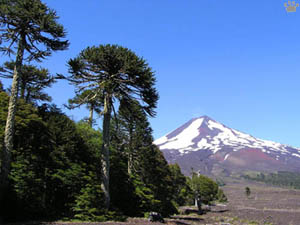
Chilean araucarias (Araucaria araucana), Parque Nacional Conguillo, Chile.
The Andes Part 2: The Andes of Chile
|
If Peruvian Andes are the most biologically diverse, the Andes of Chile are
the most beautiful. They look like a mirror image of the Pacific Coast of North
America, but with totally different flora and fauna.
|
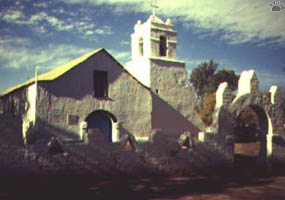
Aymara church, Parque Nacional Lauca, Northern Chile. |
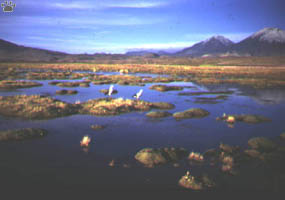
Andean geese (Chloephaga melanoptera), PN Lauca. |
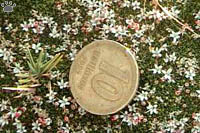
Puna flowers (x2), Aconcagua Valley, Chile. |
Lush forests of Central and Southern Chile are an
ecological island, isolated from the rest of the continent by deserts and mountains,
but sharing some ancient plants and animals with New Zealand. |
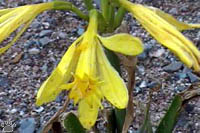
Unidentified flower, RN Las Chinchillas. |
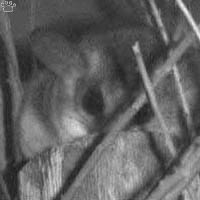
Chilean mouse opossum (Thylamys elegans) is
the only marsupial of Northern Chile. Reserva
Nacional Las Chinchillas, Chile. |
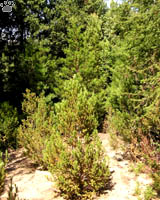
Podocarps are the most widespread of Chilean conifers. Podocarpus
andina
(small) and P. salignus, Rio Clarillo NP. |
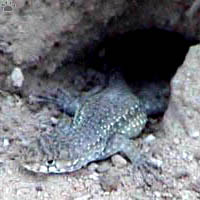
At least fifty species of Liolaemus lizards
occur throughout Chile. Parque Nacional Rio
Clarillo. |
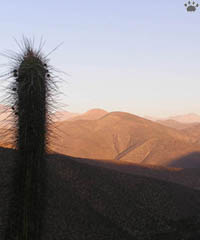
Reserva Nacional Las Chinchillas, Chile. |
Central Chile has Mediterranean climate, changing
into absolute desert further north. Reserva Nacional
Las Chinchillas at the edge of the desert is a good place to see rare rodents,
birds, and other creatures. Spotlighting for small mammals is especially good
there. |

Austrocereus cactus, Las Chinchillas. |
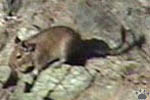 |
Rodents of Central Chile, upper
row, left to right: chinchilla rat (Abrocoma bennettii), leaf-eared mouse
(Phyllotis xanthopygus), beetle mouse (Abrothrix longipilis), chinchilla
mouse (Eoneomys chinchilloides); middle row - degu (Octodon degus),
greater long-clawed mouse (Chelemys macronyx); bottom row -Andean rat (Chroeomys
andinus), long-tailed chinchillas (Chinchilla lanigera, two photos).
Reserva Nacional Las Chinchillas, Chile. |
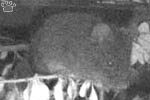 |

Santiago, the capital of Chile. |
It is also the only part of the country with relatively
dense population. Northern and Southern Chile are the most sparsely populated
areas of South American Continent, with small towns often separated by hundreds
of miles of pristine wilderness. |
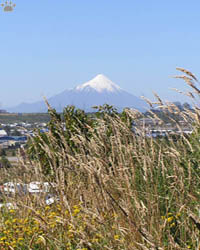
View of Osorno Volcano from Puerto Montt. |
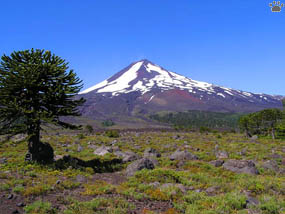 |
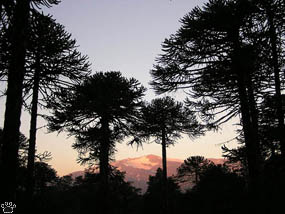 |
| Chilean araucarias, PN Conguillo. |
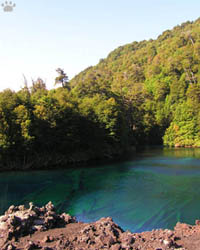
Laguna Arco Iris (Rainbow Lake), Parque
Nacional Conguillo. |
Chilean National parks are usually much more diverse,
more scenic, and less crouded than similar parks in adjacent Argentina. Transportation
in Chile, either by a rental car or public transport, is much cheaper and more
effective. My personal favorites in Valdivian forest zone are Conguillo and Alerce
National Parks. |
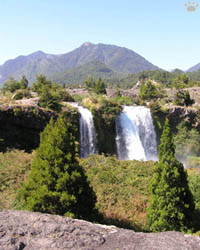
Chilean cedars (Austrocedrus chilensis),
Conguillo. |
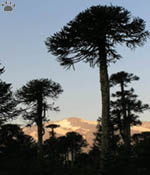
Araucarias and Llaima Volcano,
Conguillo. |
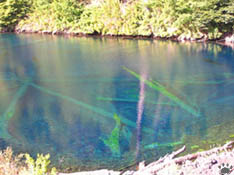
Laguna Arco Iris,
Conguillo. |
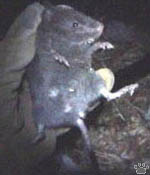
Chilean mole mouse (Geoxus
valdivianus), Conguillo. |
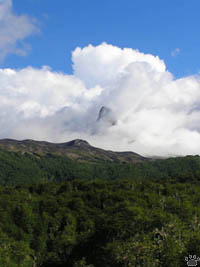
Parque Nacional Alerce Andino, Chile. |
Chilean National parks are usually much more diverse,
more scenic, and less crouded than similar parks in adjacent Argentina. Transportation
in Chile, either by a rental car or public transport, is much cheaper and more
effective. My personal favorites in Valdivian forest zone are Conguillo and Alerce
Andino National Parks. |
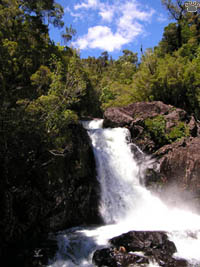
Parque Nacional Alerce Andino, Chile. |
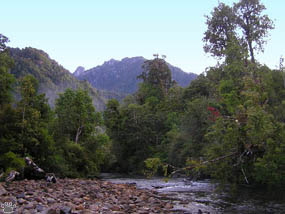 |
 |
| Parque Nacional Alerce, Chile. |
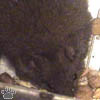
Chilean rock rat
(Aconaemus fuscus),
Conguillo. |
Many Chilean National parks have excellent trail networks.
Wonderful forests from Temuco area in the north to Coyaque region in the south
are the best hiking country in South America. A naturalist would find them even
more interesting, because almost all animals and plants there are unique for Chile
and adjacent parts of Argentina. |
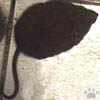
Malleco rock rat
(A. sagei),
Alerce Andino. |
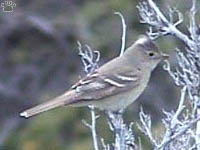
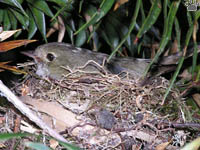
White-crested elaenias (Elaenia albiceps),
Conguillo. |
Look for the world's oldest living mammal - a tiny
creature called monito del monte (Dromicops australis),
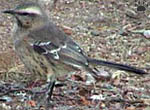
Chilean mockingbird (Mimus thenca), Temuco.
ancient frogs, opilionids, terrestrial leeches, conifers, ferns, mosses, and
velvet worms (Onychophora).
|
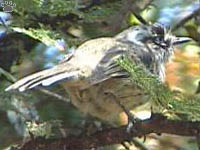 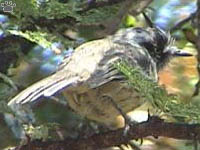
Tufted tit-tyrant (Anairetes parulus),
Conguillo. |
 |
 | 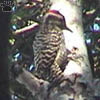 | 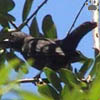 |  |
 |
 |
Birds of Central Chile, upper row,
left to right: Chilean pigeon (Columba araucana, 2 photos), striped woodpecker
(Picoides lignarius), Austral blackbird (Curaeus curaeus), rufous-tipped
plantcutter (Phytotoma rara, two photos); medium row: grey-hooded sierra-finch
(Phrygilus gayi), least seedsnipe (Thinocorus rumicivorus); bottom
row: Des Mur's wiretail (Sylviorthorhynchus desmuirsii, four photos). PN
Alerce Andino. |
 |
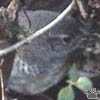
Orange-flanked tapaculo
(Eugralla parradoxa),
PN Alerce Andino. |
Chile is a birdwatcher's paradise. Most birds are easy to find
and see, even those that are very shy in other parts of South America, such as
tapaculos (Rhinocryptidae). All nine Chilean species can be seen with little effort
within a few days. Raptors, owls, even flamingos tend to be easily approachable. |
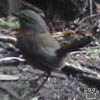
Chucao tapaculo
(Scelorchilus rubecula),
PN Alerce Andino. |
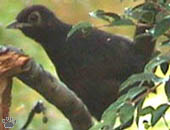 |
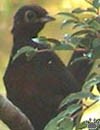
|
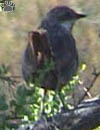 |
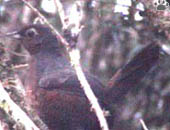 |
| Tapaculos of Chile, left to right:
black-throated huet-huet (Pteroptochos tarnii, 2 photos), moustached turca
(P. megapodius), chestnut-throated huet-huet (P. castaneus). Alerce
Andino, Rio Clarillo, and Laguna de Laja National Parks, respectively. |

Sadopuphos, worl's largest opilionid. Isla Chiloe. |
Numerous weird and beautiful creatures hide under
logs, loose bark, dry leaves, and rocks in Chilean forests. Identifying them can
be difficult, because the area is inadequately studied, and little literature
is available. |
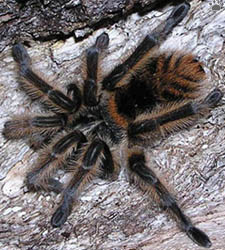
Psychsophricus spider, Rio Clarillo. |
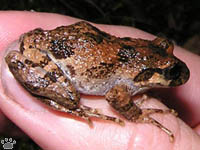 |
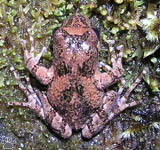 |
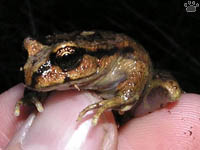 |
| Batrachyla frogs, PN Alerce
Andino. |
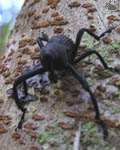
Giant weevil, PN Conguillo. |
Among the little-known inhabitants of Chilean forests
are cave glowworms. They, too, are the remnants of ancient Antarctic fauna. In
New Zealand, their cave colonies are a major tourist attraction. Chilean glowworms
are much smaller and less famous. They are actually tiny gnat larvae, who use
their lights to attract even smaller insects to their traps - sticky threads hanging
down from cave ceilings. |
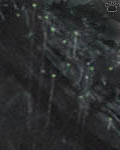
Glowworms, Alerce Andino. |
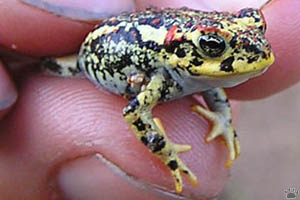
Baby Bufo toad, Reserva Nacional Las Chinchillas,
Chile. |
Part 3. The Patagonian Andes
Back to Part 1
Home
|